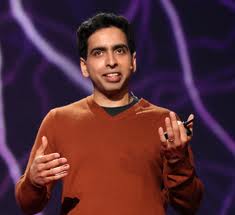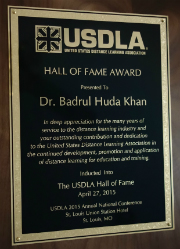Is Salman “Sal” Khan of khanacademy.org related to Badrul Khan?
Not by blood relation, but by common interest and passion for meaningful e-learning. Sal was born in the US and Badrul was born in Bangladesh. Both are Bangladeshi American.
 |
 |
Why is it a framework not a model?
Dictionary.com states a framework as “a frame or structure composed of parts fitted and joined together, or a skeletal structure designed to support or enclose something.” Similarly, Khan’s E-Learning Framework is an eight sided structural frame for e-learning. All of its sides (representing specific e-learning issues) are systemically interconnect to support learning. The e-learning framework ensures that the boundaries (i.e., the eight sides) of e-learning environment are well marked so that desired learning outcomes are achieved through a comprehensive and systemic understanding of interconnected issues from all sides.
It does not qualify as a model because it does not give specific prescription to develop a learning environment.
Any other e-learning model(s) developed by Khan?
Khan’s brand new E-Learning Process Model.
Khan developed E-Learning People-Process-Product (P3) Contiuum and CAPEODL (Comprenhensive Approach to Program Evaluation in Open and Distributed Learning).
Does Khan’s Framework based on any theoretical fondation?
The seeds for the e-learning framework began germinating with the question, “What does it take to provide flexible learning environments for learners worldwide?” To investigate the question, Khan interviewed, dialogued with e-learning stakeholders and review of documents from all over the world from 1996 to 2001. It is an emergent design! Scholars from several disciplines (instructional design, cognitive sciences, systems sciences, law, and health care) reviewed the framework and provided insightful feedback for improvement. Therefore, the framework is not based a specific theory, rather a systemic combination of multiplicity of theories from different disciplines. It is a common sense making framework to help create meaningful flexible learning for diverse learners.
How to best use Khan’s Framework?
The framework has been used by researchers and practitioners around the globe. Obviously, there is a quick-fix tendency among some developers in the e-learning industry. They look for tools that can get their products done quickly. We have to remember, tools are just tools! In e–learning, “e” relates to technology tools and learning relates to pedagogy and context. In e-learning, “Pedagogy guides technology, not vice versa.” (Khan, 2011).
But all of us who have been involved in creating meaningful learning for online environments, we know, e-learning is different. It’s not like traditional classroom-based closed learning system. E-learning is an open and distributed learning system where learners and learning materials may or may not locate at the same place. Therefore, learning and learners’ issues are very complex. For e-learning, we really need to do comprehensive reviews of all interconnected and relevant issues to develop cross-culturally sensitive flexible learning environments for globally diverse learners. Quick fix won’t work! We have to face the reality. We want our e-learning programs to have higher retention rate. We don’t want to see participants in e-learning leave the program because of poor design. A good aricle to read is Alex Romiszowsky’s The future of E-learning as an educational innovation: Factors influencing project success and failure. It is, therefore, very crtical that we examine all relevant factors for successful e-learning.
The framework helps to identify myriad of critical issues that we should consider for our own leaning context and audience. Also remember, one size does not fit all. Those who are not seriously about investigating various critical issues encompassing the eight dimensions of e-learning environment, they may not do justice to all stakeholders of e-learning. The framework advocates the fullfillment of stakeholders needs. We welcome your feedback to improve the utility of the Khan’s E-Learning Framework.

